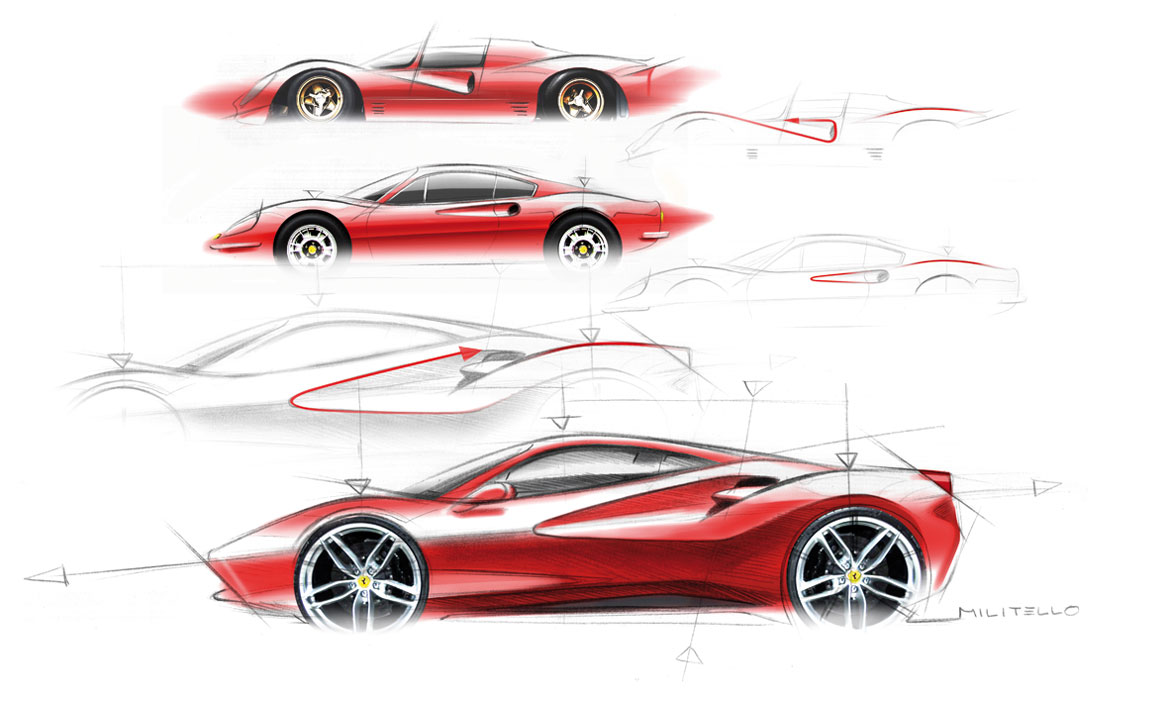The Ferrari 488 GTB is the successor to the 458 Italia, and its name pays homage to the 308 GTB, the progenitor of the two-seater rear mid-engined V8 family presented all of forty years ago. But the 488 also ushers in a new development evocative of today’s F1, with two turbos – and related ancillaries – used for the first time to boost the power of the V8 to 670 hp. The new car posed an exciting challenge for the Centro Stile headed by Flavio Manzoni: to create an all-new Ferrari echoing the 458 in architecture, but incorporating evolved technical content to become an intrinsically sculptural and artistic iconic new model.

Yet again, the creation of such a high-tech Ferrari was only possible through complete symbiosis with the engineers: and the design also improves the aerodynamics of the new 488 and increases downforce by 50%, with a body that does away entirely with the superfluous, and new solutions bringing each single element into perfect harmony with the whole. This is already clear in the front volume, with scalloped surfaces where permitted by the mechanicals beneath, and a nose that loses the grille and ‘smile’ of other Ferraris to adopt a much more classic, race-inspired look, making room for the gaping apertures for the two large radiators and the full-width suspended front wing. The overall effect is functional, but also evocative of the nose of an F1 racer.

The side view exudes character, with wheel-hugging front fenders like the Dino and original 308, while the flanks are deeply sculpted, with side skirts jutting prominently at the base, and the side daylight opening kicks up sharply at the end like a whiplash towards the tail. The deep recess starting at the centre of the door also cites the 1970s GTB, and ends in a huge air intake split into two by a central vane, defining the distinct character of the extremely broad shoulders spanning the rear wheels. The need for an air intake feeding the intercoolers of the two turbos and the induction system was used as an opportunity to create an extra aerodynamic duct which improves down-force and allowed the designers to give the car a naturally sleek tail.
The blown rear spoiler is fully integrated into the tail without looking like an appendage. The tail sits over air vents between the new three dimensional ring taillights in a perfectly coherent design that is wider and lower than before, and also includes a diffuser with active aero flaps, raised twin tailpipes and a central LED lamp – another F1 cue – while the original new aerodynamic undertray, with vortex generators, is hidden from view.

The same principle of subtracting rather than adding and sculptural coherence fused with advanced, pure engineering is also applied in the cabin. Everything is driver-focused, with all main vehicle controls on the multifunction steering wheel, including the ubiquitous ‘manettino’ selector, and on the lateral satellite pods, which also include the distinctive slanted air vents. The dashboard is wing-shaped while the centre console is visually separated from the rest of the interior, and studded with prominent buttons controlling the F1-trac gearbox and hazard warning lights. The dash, like the centre console and door panels, is split into two distinct zones with different trim, leaving customers ample scope for personalising colour and materials, while the form-hugging seats interpret classic Ferrari seats of the past in a modern key, combining sports with comfort. Every element has a distinct character – even the key of the 488, with keyless start, is reminiscent of the engine’s intake plenums.
The article continues in Auto&Design no. 214











